MITSUBISHI COLT 2008 (in English) Owners Manual
Manufacturer: MITSUBISHI, Model Year: 2008, Model line: COLT, Model: MITSUBISHI COLT 2008Pages: 450, PDF Size: 14.57 MB
Page 91 of 450
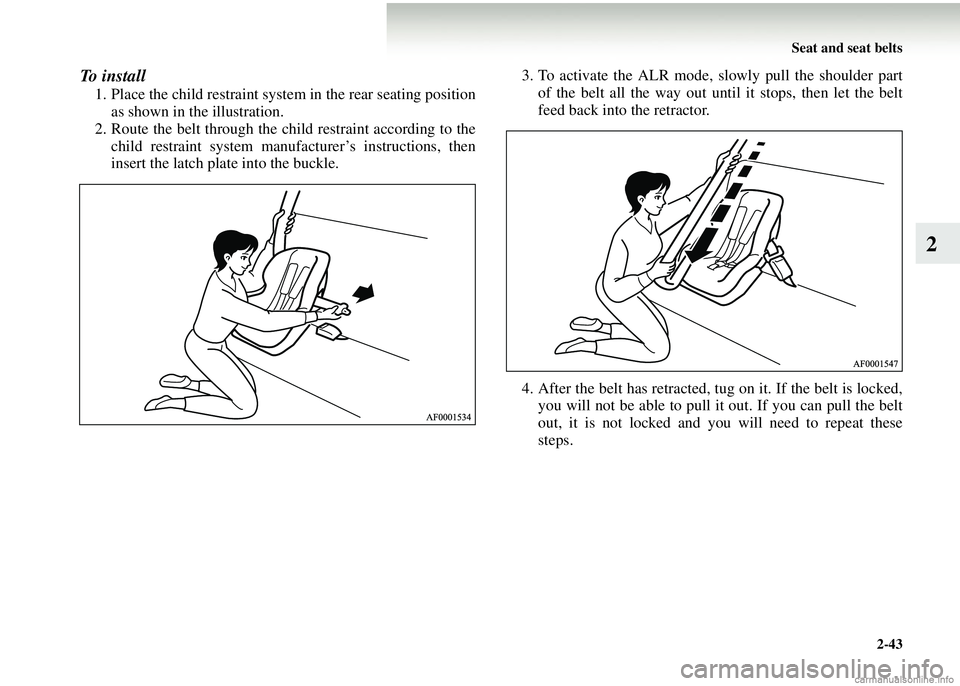
Seat and seat belts2-43
2
To i n s t a l l
1. Place the child restraint system in the rear seating positionas shown in the illustration.
2. Route the belt through the child restraint according to the
child restraint system manuf acturer’s instructions, then
insert the latch plate into the buckle. 3. To activate the ALR mode, slowly pull the shoulder part
of the belt all the way out until it stops, then let the belt
feed back into the retractor.
4. After the belt has retracted, tug on it. If the belt is locked, you will not be able to pull it out. If you can pull the belt
out, it is not locked and you will need to repeat these
steps.
Page 92 of 450
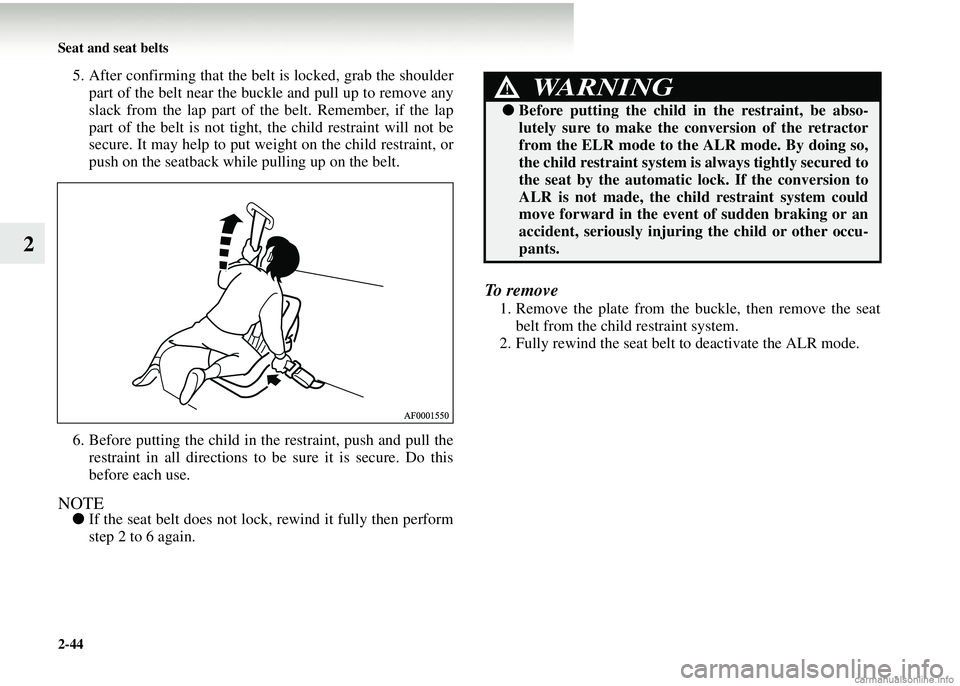
2-44 Seat and seat belts
2
5. After confirming that the belt is locked, grab the shoulderpart of the belt near the buckle and pull up to remove any
slack from the lap part of the belt. Remember, if the lap
part of the belt is not tight, the child restraint will not be
secure. It may help to put weight on the child restraint, or
push on the seatback while pulling up on the belt.
6. Before putting the child in the restraint, push and pull the restraint in all directions to be sure it is secure. Do this
before each use.
NOTE● If the seat belt does not lock, rewind it fully then perform
step 2 to 6 again.
To remove
1. Remove the plate from the buckle, then remove the seat
belt from the child restraint system.
2. Fully rewind the seat belt to deactivate the ALR mode.
WARNING!
●Before putting the child in the restraint, be abso-
lutely sure to make the conversion of the retractor
from the ELR mode to the ALR mode. By doing so,
the child restraint system is always tightly secured to
the seat by the automatic lock. If the conversion to
ALR is not made, the chil d restraint system could
move forward in the event of sudden braking or an
accident, seriously injuring the child or other occu-
pants.
Page 93 of 450
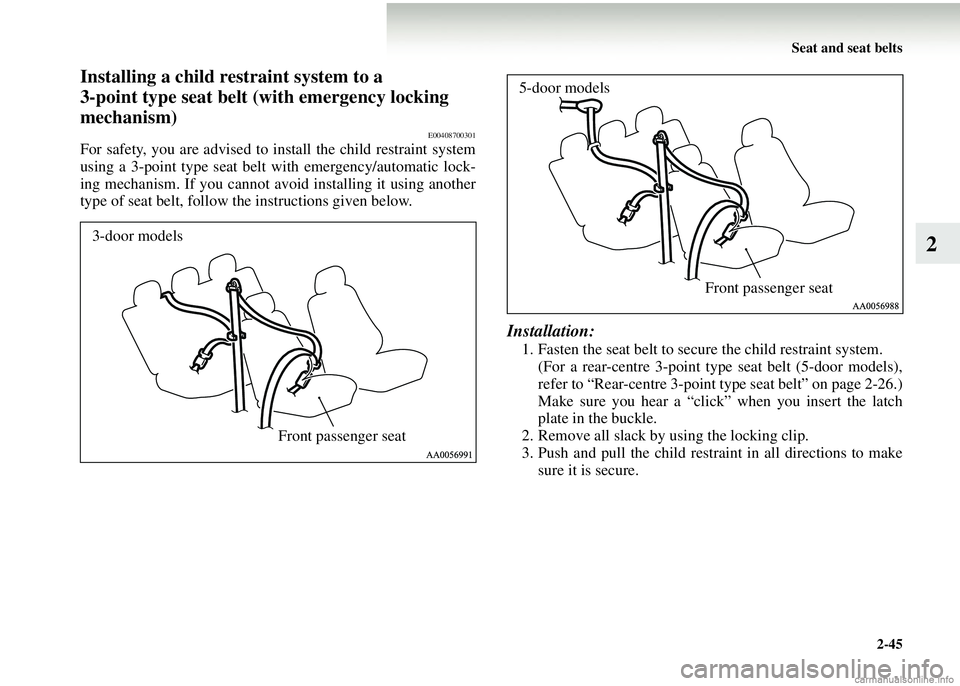
Seat and seat belts2-45
2
Installing a child restraint system to a
3-point type seat belt (with emergency locking
mechanism)
E00408700301
For safety, you are advised to install the child restraint system
using a 3-point type seat belt with emergency/automatic lock-
ing mechanism. If you cannot avoid installing it using another
type of seat belt, follow the instructions given below.
Installation:
1. Fasten the seat belt to secu re the child restraint system.
(For a rear-centre 3-point type seat belt (5-door models),
refer to “Rear-centre 3-point t ype seat belt” on page 2-26.)
Make sure you hear a “click” when you insert the latch
plate in the buckle.
2. Remove all slack by using the locking clip.
3. Push and pull the child restraint in all directions to make sure it is secure.
Front passenger seat
3-door models
Front passenger seat
5-door models
Page 94 of 450
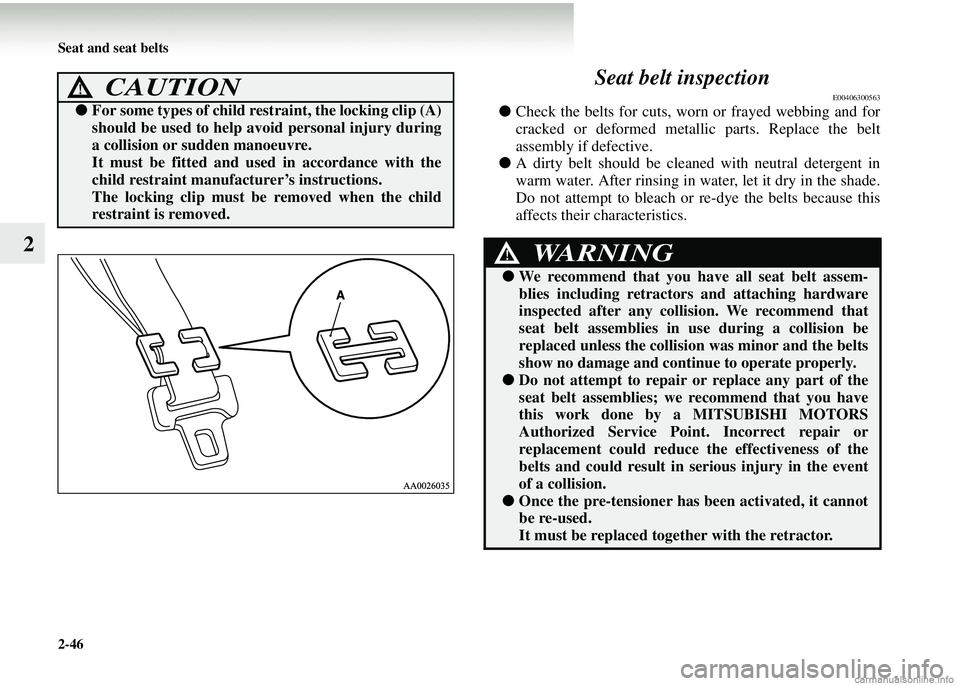
2-46 Seat and seat belts
2Seat belt inspection
E00406300563
●
Check the belts for cuts, worn or frayed webbing and for
cracked or deformed metallic parts. Replace the belt
assembly if defective.
● A dirty belt should be cleaned with neutral detergent in
warm water. After rinsing in water, let it dry in the shade.
Do not attempt to bleach or re-dye the belts because this
affects their characteristics.
CAUTION!
●For some types of child rest raint, the locking clip (A)
should be used to help avoid personal injury during
a collision or sudden manoeuvre.
It must be fitted and us ed in accordance with the
child restraint manufacturer’s instructions.
The locking clip must be removed when the child
restraint is removed.
WARNING!
● We recommend that you have all seat belt assem-
blies including retractors and attaching hardware
inspected after any collis ion. We recommend that
seat belt assemblies in use during a collision be
replaced unless the collision was minor and the belts
show no damage and continue to operate properly.
● Do not attempt to repair or replace any part of the
seat belt assemblies; we recommend that you have
this work done by a MITSUBISHI MOTORS
Authorized Service Point. Incorrect repair or
replacement could reduce th e effectiveness of the
belts and could result in s erious injury in the event
of a collision.
● Once the pre-tensioner has been activated, it cannot
be re-used.
It must be replaced together with the retractor.
Page 95 of 450
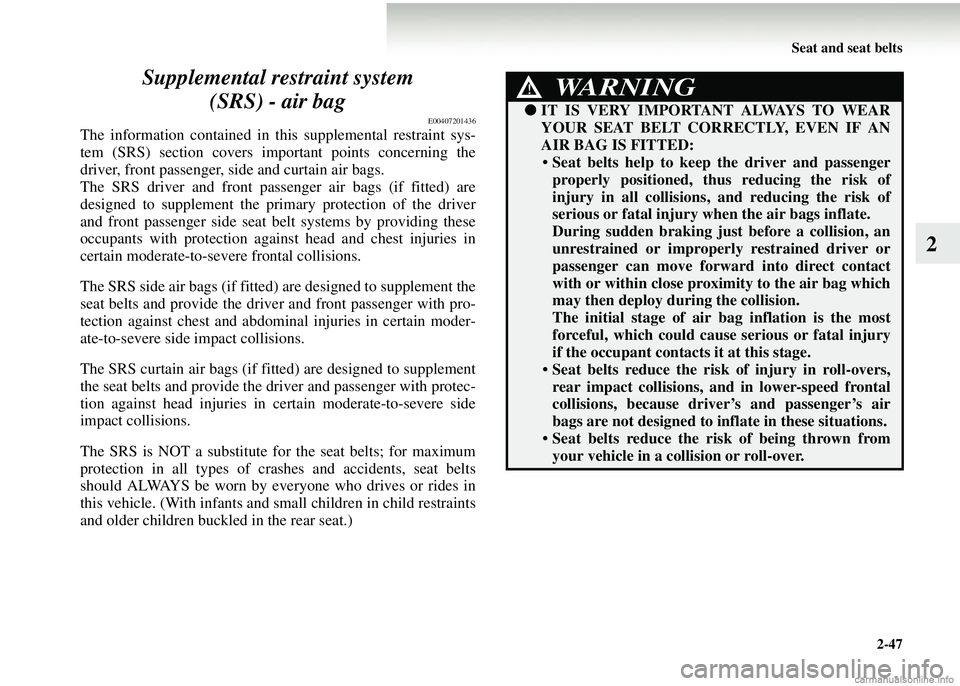
Seat and seat belts2-47
2
Supplemental restraint system
(SRS) - air bag
E00407201436
The information contained in this supplemental restraint sys-
tem (SRS) section covers important points concerning the
driver, front passenger, side and curtain air bags.
The SRS driver and front passenger air bags (if fitted) are
designed to supplement the primary protection of the driver
and front passenger side seat belt systems by providing these
occupants with protection agains t head and chest injuries in
certain moderate-to-severe frontal collisions.
The SRS side air bags (if fitted) are designed to supplement the
seat belts and provide the driver and front passenger with pro-
tection against chest and abdomin al injuries in certain moder-
ate-to-severe side impact collisions.
The SRS curtain air bags (if fitt ed) are designed to supplement
the seat belts and provide the driver and passenger with protec-
tion against head injuries in certain moderate-to-severe side
impact collisions.
The SRS is NOT a substitute for the seat belts; for maximum
protection in all types of cras hes and accidents, seat belts
should ALWAYS be worn by everyone who drives or rides in
this vehicle. (With infants and small children in child restraints
and older children buckle d in the rear seat.)
WARNING!
●IT IS VERY IMPORTANT ALWAYS TO WEAR
YOUR SEAT BELT CORRECTLY, EVEN IF AN
AIR BAG IS FITTED:
• Seat belts help to keep the driver and passenger
properly positioned, thus reducing the risk of
injury in all collisions, and reducing the risk of
serious or fatal injury when the air bags inflate.
During sudden braking just before a collision, an
unrestrained or improperly restrained driver or
passenger can move forward into direct contact
with or within cl ose proximity to the air bag which
may then deploy during the collision.
The initial stage of air bag inflation is the most
forceful, which could caus e serious or fatal injury
if the occupant contac ts it at this stage.
• Seat belts reduce the risk of injury in roll-overs,
rear impact collisions, and in lower-speed frontal
collisions, because driver’s and passenger’s air
bags are not designed to inflate in these situations.
• Seat belts reduce the risk of being thrown from
your vehicle in a collision or roll-over.
Page 96 of 450
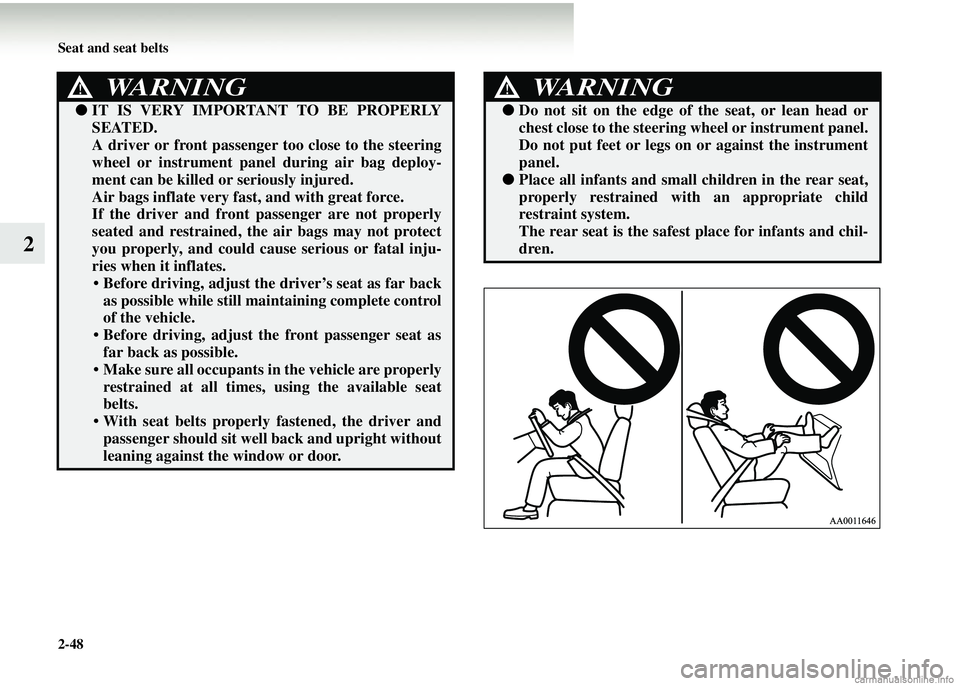
2-48 Seat and seat belts
2
WARNING!
●IT IS VERY IMPORTANT TO BE PROPERLY
SEATED.
A driver or front passenger too close to the steering
wheel or instrument panel during air bag deploy-
ment can be killed or seriously injured.
Air bags inflate very fa st, and with great force.
If the driver and front passenger are not properly
seated and restrained, th e air bags may not protect
you properly, and could caus e serious or fatal inju-
ries when it inflates.
• Before driving, adjust the driver’s seat as far back
as possible while still maintaining complete control
of the vehicle.
• Before driving, adjust the front passenger seat as far back as possible.
• Make sure all occupants in the vehicle are properly
restrained at all times, using the available seat
belts.
• With seat belts properly fastened, the driver and
passenger should sit well back and upright without
leaning against the window or door.
WARNING!
● Do not sit on the edge of the seat, or lean head or
chest close to the steering wheel or instrument panel.
Do not put feet or legs on or against the instrument
panel.
● Place all infants and small children in the rear seat,
properly restrained with an appropriate child
restraint system.
The rear seat is the safest place for infants and chil-
dren.
Page 97 of 450
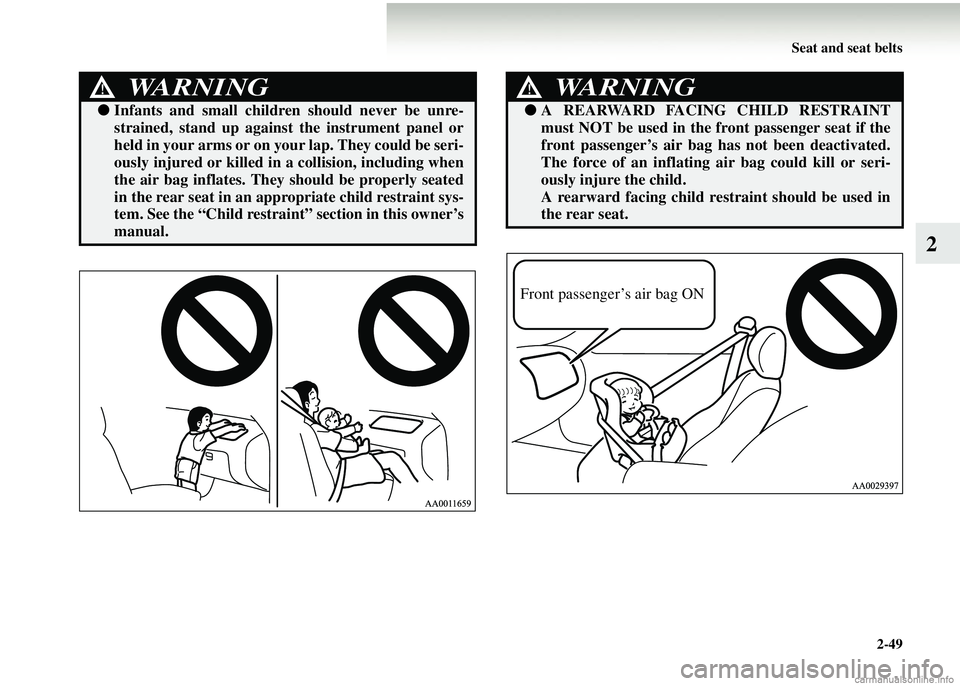
Seat and seat belts2-49
2
WARNING!
●Infants and small children should never be unre-
strained, stand up agains t the instrument panel or
held in your arms or on you r lap. They could be seri-
ously injured or killed in a collision, including when
the air bag inflates. They should be properly seated
in the rear seat in an a ppropriate child restraint sys-
tem. See the “Child restraint” section in this owner’s
manual.
WARNING!
● A REARWARD FACING CHILD RESTRAINT
must NOT be used in the front passenger seat if the
front passenger’s air bag has not been deactivated.
The force of an inflating air bag could kill or seri-
ously injure the child.
A rearward facing child re straint should be used in
the rear seat.
Front passenger’s air bag ON
Page 98 of 450
![MITSUBISHI COLT 2008 (in English) Owners Manual 2-50 Seat and seat belts
2
NOTE[Vehicles with front passenger’s air bag ON-OFF switch]● If you have a rearward facing child restraint system that
cannot be fitted to any seat other than the front MITSUBISHI COLT 2008 (in English) Owners Manual 2-50 Seat and seat belts
2
NOTE[Vehicles with front passenger’s air bag ON-OFF switch]● If you have a rearward facing child restraint system that
cannot be fitted to any seat other than the front](/img/19/34848/w960_34848-97.png)
2-50 Seat and seat belts
2
NOTE[Vehicles with front passenger’s air bag ON-OFF switch]● If you have a rearward facing child restraint system that
cannot be fitted to any seat other than the front passenger
seat, be sure to turn OFF the front passenger’s air bag ON-
OFF switch before using it. (R efer to “To turn an air bag
off” on page 2-54.)
Front passenger’s air bag OFF
WARNING!
● A FORWARD FACING CHILD RESTRAINT
should be used in the rear seat whenever possible; if
it must be used in the front passenger seat, adjust
the seat to the most rearward position. Failure to do
so could kill or cause s erious injury to the child.
WARNING!
●Older children should be seated in the rear seat,
properly wearing the seat belt, with an appropriate
booster seat if needed.
Page 99 of 450
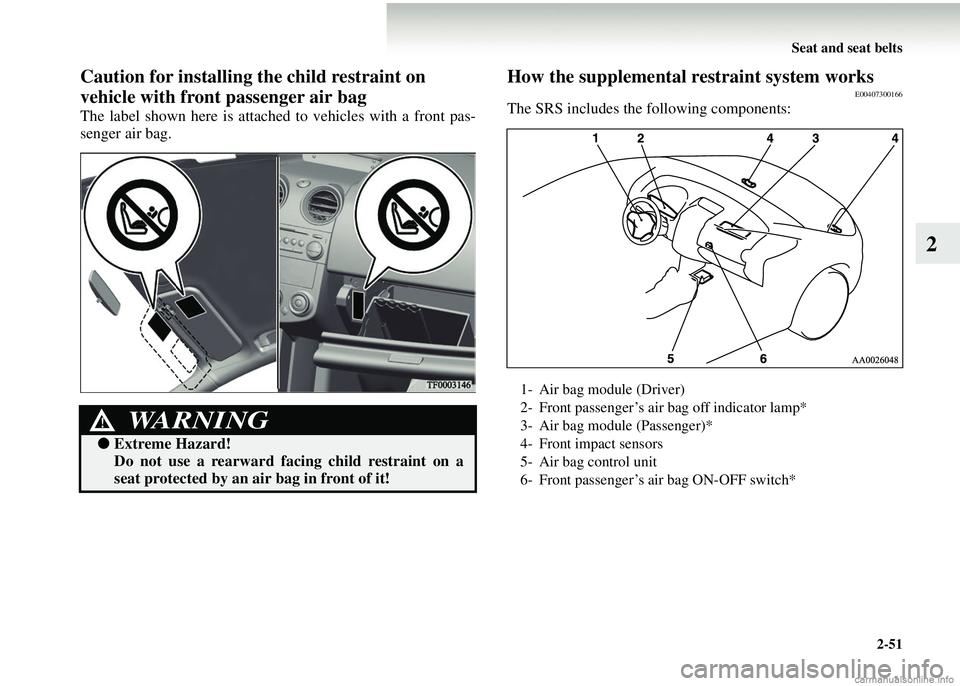
Seat and seat belts2-51
2
Caution for installing the child restraint on
vehicle with front passenger air bag
The label shown here is attached to vehicles with a front pas-
senger air bag.
How the supplemental restraint system worksE00407300166
The SRS includes the following components:
WARNING!
●Extreme Hazard!
Do not use a rearward faci ng child restraint on a
seat protected by an ai r bag in front of it!
1- Air bag module (Driver)
2- Front passenger’s air bag off indicator lamp*
3- Air bag module (Passenger)*
4- Front impact sensors
5- Air bag control unit
6- Front passenger’s air bag ON-OFF switch*
Page 100 of 450
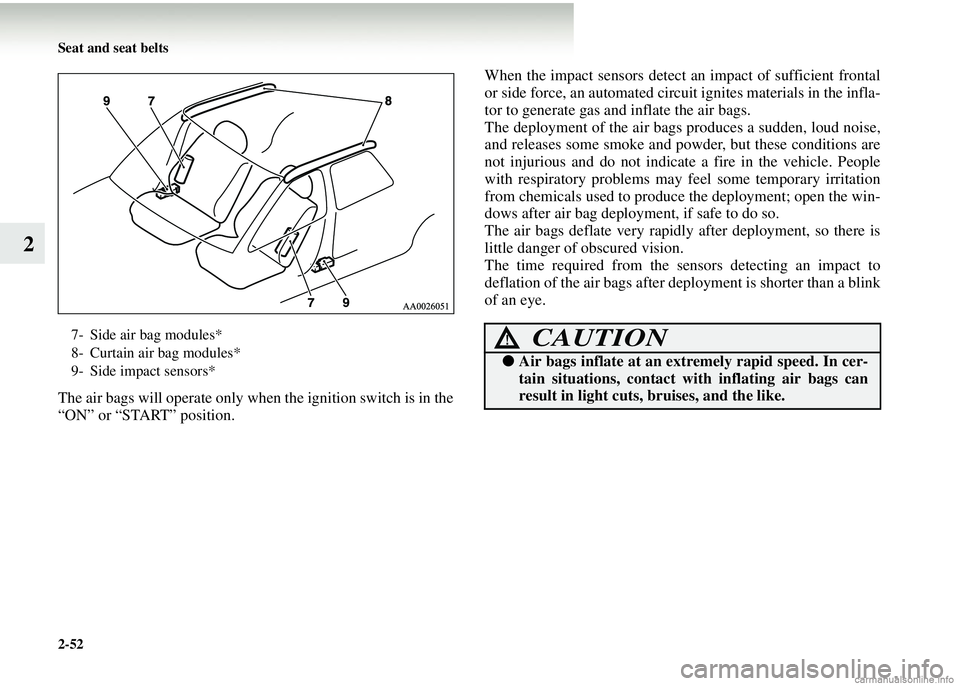
2-52 Seat and seat belts
2
The air bags will operate only when the ignition switch is in the
“ON” or “START” position.When the impact sensors detect
an impact of sufficient frontal
or side force, an automated circuit ignites materials in the infla-
tor to generate gas and inflate the air bags.
The deployment of the air bags produces a sudden, loud noise,
and releases some smoke and powder, but these conditions are
not injurious and do not indicate a fire in the vehicle. People
with respiratory problems may feel some temporary irritation
from chemicals used to produce the deployment; open the win-
dows after air bag deployment, if safe to do so.
The air bags deflate very rapidl y after deployment, so there is
little danger of obscured vision.
The time required from the sensors detecting an impact to
deflation of the air bags after deployment is shorter than a blink
of an eye.
7- Side air bag modules*
8- Curtain air bag modules*
9- Side impact sensors*CAUTION!
● Air bags inflate at an ex tremely rapid speed. In cer-
tain situations, contact with inflating air bags can
result in light cuts, bruises, and the like.